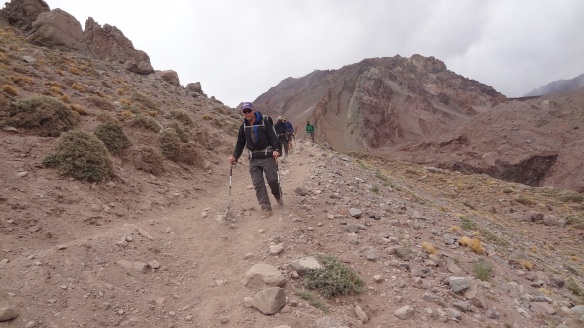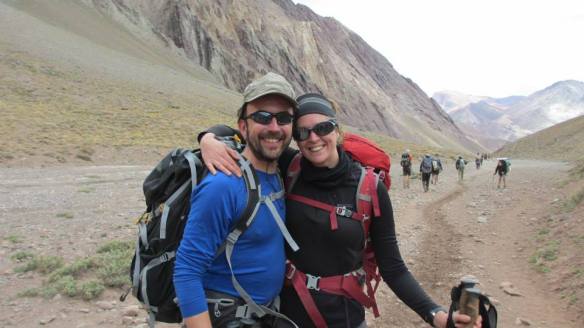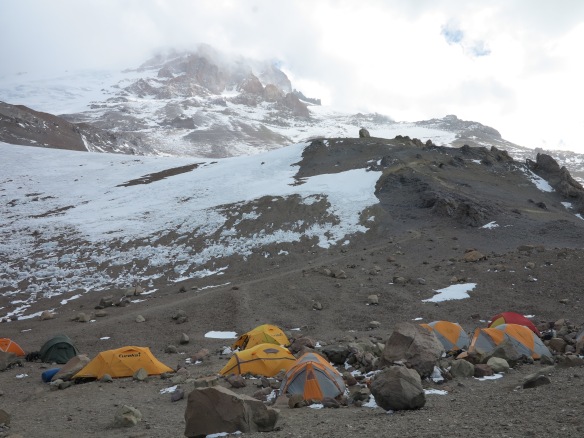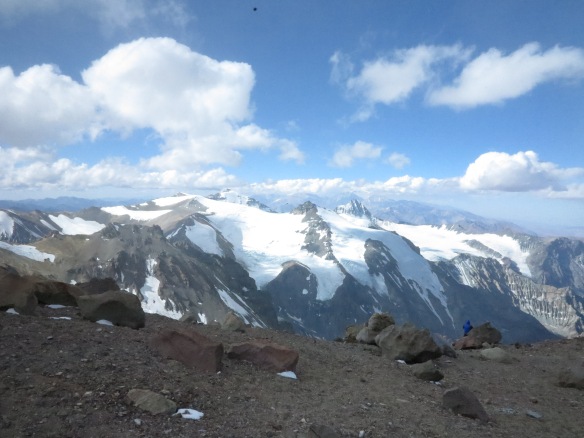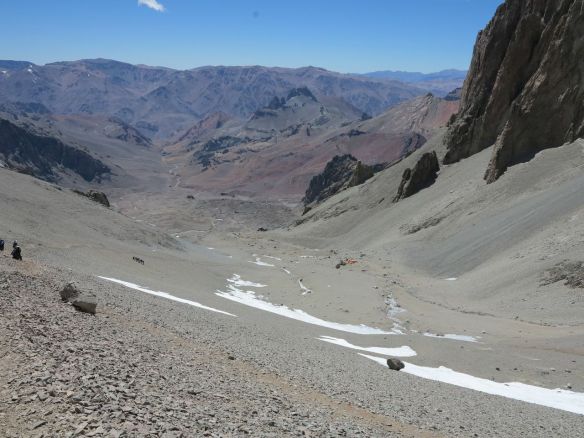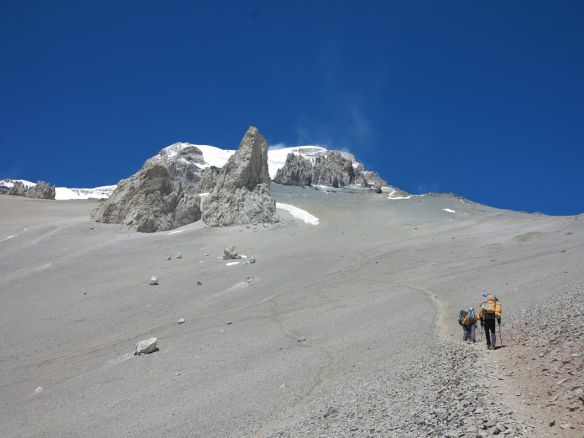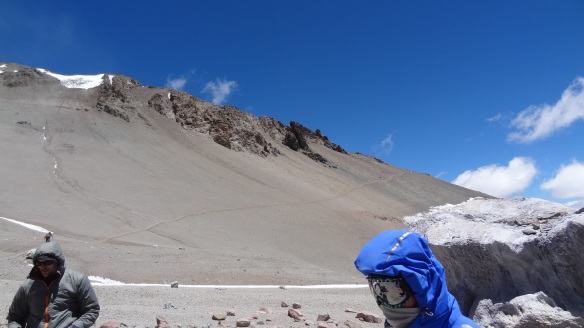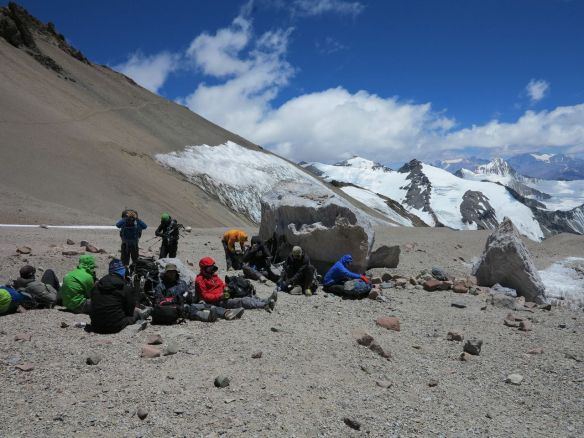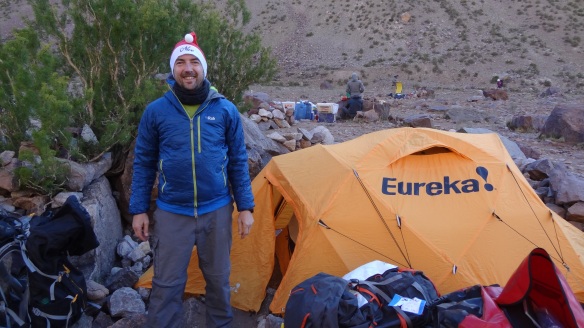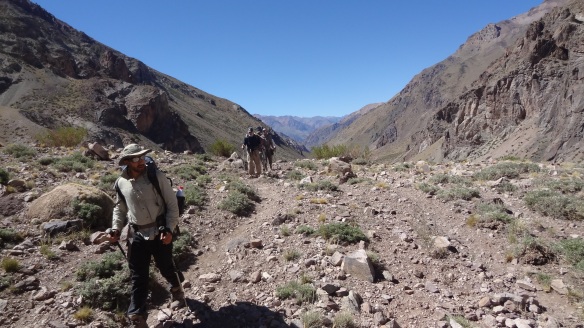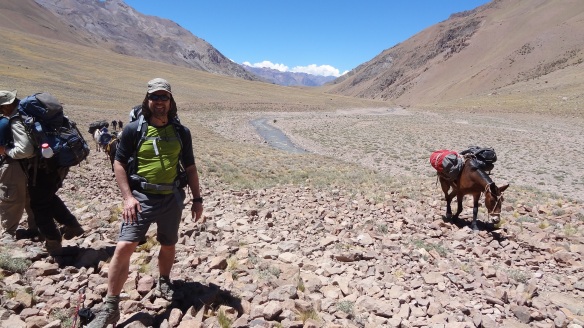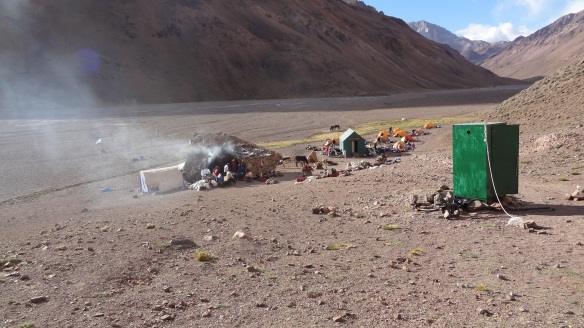So the (very) last day on Aconcagua began with an earlier wake up call than anticipated. The tent (complete with bunk beds, no less!) that Mohammed and I were now sharing with four other US climbers, who were just commencing their climb up the mountain, saw them rise at about 6.30 to get ready. As we didn’t really have to be anywhere before 9am, then this was a bit of a waste of badly needed sleep. But no matter, we had packing to finish anyway and get our duffles ready for the mules who would take them down the remainder of the mountain for us. Our carrying days were done, it was just half a rucksack from here.
After a final breakfast at Base Camp we set off from our base at 14,200 feet to take us down to the trailhead via the ‘Normal Route’. Our journey had effectively taken us on a 360 degree tour of Aconcagua, starting from the south east going north, and now heading due south from the North Western corner. To get to the trailhead was a fairly simple trek out of just over 20 miles.
Leaving Base Camp was a bit of a nostalgic affair for me. Having tried not to make any snap decisions about the future, I didn’t know if I’d ever be back for another go. It’s a massive commitment in time and money to get this far and not summit, and so I had a lot of evaluating to do when I returned home. Did I belong at 7,000m? Questionably nobody does, but some people make it and some don’t, and I hadn’t, simple as that.

We didn’t expect to be in down jackets for the trek out, but it made it easier really overall, as it was cool and windy, if a bit dusty.
The trek out was cool and windy, a sharp contrast to the two warm days before. We passed most of the time by playing word games, like where you name countries or cities and have to start with the last letter of the word used by the person in front of you. I think we ended up with Eduardo winning one and me one, by which time we had had enough. We had a brief break at Camp Confluenzia on the way down at about 12 miles, an overnight stop for those coming up the mountain by the Normal route.
Just after we’d left Confluenzia, a fabulous chance meeting occurred. I saw Jo Tomlinson, with whom I’d climbed Elbrus in August, heading up the valley on the path next to us! Whilst I knew fine well that Jo was heading up the mountain at about this time, I had no idea what day, time or route she was taking (she with Jagged Globe, I with IMG). So the fact that we passed within 3 feet of each other and got to say hello and exchange a big hug was a fabulous moment for me. It quite made my day. I only regret that I didn’t get a photograph of the two of us, although one of her friends did, and if I get hold of it later I’ll put it up here for sure. I wish Jo all the luck in the world in her own summit attempt. At the time of writing this she is hopefully positioned somewhere around Camp 2 with a summit attempt in the next week. Fingers crossed 🙂
We got to the trailhead at about 3.30pm, a six and a half hour trek, at a fair pace most of the way. From there we were met by a Grajales van who picked up us and our duffles from the mules. We were initially taken back to the Los Penitentes Hotel to collect the things that we had left there pre-Christmas, and from there it was a two hour drive back to Mendoza, where we arrived at about 8pm.
So that was that. It was over, after two and a half weeks, 14 of them on the mountain itself.
Both Gary and Mohammed got early flights out of Mendoza to get them home ahead of time. Because we had summited on the first available day of the schedule, we were effectively down three days early. I tried to get an early flight too, but the cost was prohibitive, around $1,000. I thus decided to hang around in Mendoza’s sunshine and take in the sights. Each of Pete, Fred and Eduardo did too, and we went on a couple of winery tours, ate steak until we couldn’t eat steak any more, and drank our share of what Mendoza is famous for – Malbec. They were a wonderful few days.
Our final evening when we were all together was on the Wednesday night. We were taken to a house (a friend of Tincho’s) on the edge of town, where we treated to an ‘Asado’, the Argentinian word for a long barbecue with friends. The food, of beef ribs, empanadas, cheese, vegetables and all manner of other dishes, was simply the best tasting food I have ever eaten. It was a wonderful and fitting trubute to the end of an epic and amazing adventure.

The ‘last supper’, our celebration in Mendoza – probably the best meal I have ever eaten. No, definitely the best!
It would be very remiss of me not to pay tribute here to our guides Peter, Johnny and Tincho, the former two from IMG and the latter from Grajales. Although this trip had been ‘expedition style’, whereby we’d carried our own loads and the group gear, pitched tents ourselves etc., that doesn’t take away at all from how much the guides do.
They fed us every day, they collected and treated water, they tended to our needs and also gripes and groans (of which I have to say they were very few indeed). They crucially got us up the mountain and into a position to make an attempt on the summit. Without Johnny and Tincho carrying a staggering 75kg between them the night before summit day, I believe that no-one from the group would have summitted at all. The high winds which came in the following two days would have put paid to probably even an attempt. But even more importantly than that they kept us safe. Mountaineering is a dangerous game, and Aconcagua is a dangerous mountain. People die up there and get badly sick on a regular basis. Their calm, controlled and strong leadership meant that we just had to concentrate on looking after ourselves, and keep on putting one foot in front of the other when told to. Oh if only it were so easy!
Goodbye Aconcagua, or maybe it is just ‘au-revoir’. You are my nemesis for now, and perhaps for always, but you have given me the biggest, longest and hardest adventure of my life. A journey of learning, of amazing experiences, of new friendships, of new sights and sounds. Something to be more than remembered for all time. Something that few people on the planet will ever experience. I am indeed a lucky man.

